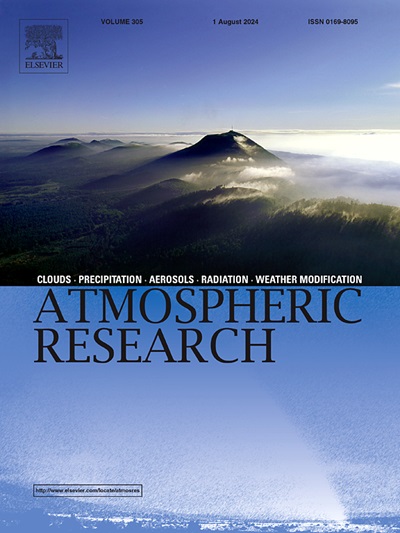印度夏季季风期间的降雨事件探测和雨量估算:全面评估不同水文气候区的网格降水数据集
IF 4.5
2区 地球科学
Q1 METEOROLOGY & ATMOSPHERIC SCIENCES
引用次数: 0
摘要
精确的降水估算是水文建模和气候研究的关键。任何地区都有不同的网格降水产品,选择最佳产品对于水文气候建模和分析至关重要。在当前的研究中,我们使用多种连续、分类、图形和基于时间间隔的性能指标,对不同空间和时间分辨率的观测(APHRODITE)、再分析(IMDAA、ERA5-Land、PGF)、卫星(IMERG、CHIRPS、PERSIANN-CDR)和混合(MSWEP)网格降水产品进行了评估,以检测印度夏季季风降雨(ISMR)事件并估算其在印度次大陆的量级,同时将基于 IMD 量表的网格数据作为参考产品。我们的分析仅限于印度次大陆的主要雨季季风季节(即 6 月至 9 月)。由于印度各地监测网络不均匀、稀疏,数据匮乏,基于雨量计的观测数据有限,因此有必要进行网格间比较评估,而不是点到网格的评估。我们提出了一个新的排序框架,以确定降水数据集在 27 个水文气候区(包括同质降雨区、柯本-盖革气候区和主要河流流域)的适用性。综合评估结果表明:(1) APHRODITE、MSWEP 和 ERA5-Land 最接近印度各地的降水事件发生情况;(2) MSWEP 和 ERA5-Land 是区域一级最合适(排名最高)的替代数据集,而 APHRODITE 由于其持续的干旱偏差被认为是下一个合适的数据集;(3) CHIRPS 和 IMERG 在印度各地的排名得分较低;(4) 在半干旱和亚湿润地区(如印度),所研究数据集的一致性非常接近。g.,而ERA5-Land、IMDAA 和 APHRODITE 则无法探测和再现印度西海岸和东北部的事件强度,(5)PGF 和 PERSIANN-CDR 是位置最靠后的数据集。此外,本研究提供了一个独特而创新的视角,来描述印度这样一个广阔的地形、生态和气候梯度地区的降水特征。本文章由计算机程序翻译,如有差异,请以英文原文为准。
Rain event detection and magnitude estimation during Indian summer monsoon: Comprehensive assessment of gridded precipitation datasets across hydroclimatically diverse regions
Accurate precipitation estimates are quintessential for hydrologic modeling and climate studies. Different gridded precipitation products are available in any region, and selecting the best one is essential for hydroclimatic modeling and analysis. In the current study, observation- (APHRODITE), reanalysis- (IMDAA, ERA5-Land, PGF), satellite-based (IMERG, CHIRPS, PERSIANN-CDR), and hybrid (MSWEP) gridded precipitation products with different spatial and temporal resolutions are evaluated using several continuous, categorical, graphical, and interval-based performance measures towards detecting Indian Summer Monsoon Rainfall (ISMR) events and estimating their magnitudes for the subcontinent of India, considering IMD gauge-based gridded data as reference product. We confine our analysis to the monsoon season (i.e., June to September), the principal rainy season in the Indian sub-continent. The dearth of data and limited rain gauge-based observations from non-uniform sparse monitoring networks across India necessitated grid-to-grid comparative evaluations instead of point-to-grid assessments. We propose a new ranking framework to determine the suitability of precipitation datasets for twenty-seven hydroclimatic regions comprising homogeneous rainfall zones, Köppen-Geiger climate zones, and major river basins. Results from the comprehensive evaluation suggest that (1) APHRODITE, MSWEP, and ERA5-Land best approximate precipitation event occurrences across India, (2) MSWEP and ERA5-Land are most suitable (highest rank) alternatives at the regional level, while APHRODITE is found to be next suitable dataset owing to its persistent dry bias, (3) CHIRPS and IMERG have reasonably lower rank score across India, (4) close agreement of examined datasets is noted over semi-arid and sub-humid regions (e.g., peninsular and central India), whereas ERA5-Land, IMDAA, and APHRODITE fail to detect and reproduce the intensity of the events along the west coast and northeastern India, (5) PGF and PERSIANN-CDR are the least situated datasets. Moreover, the present study provides a unique and innovative perspective to characterise the precipitation over a vast topographic, ecologic, and climatic gradient region like India.
求助全文
通过发布文献求助,成功后即可免费获取论文全文。
去求助
来源期刊

Atmospheric Research
地学-气象与大气科学
CiteScore
9.40
自引率
10.90%
发文量
460
审稿时长
47 days
期刊介绍:
The journal publishes scientific papers (research papers, review articles, letters and notes) dealing with the part of the atmosphere where meteorological events occur. Attention is given to all processes extending from the earth surface to the tropopause, but special emphasis continues to be devoted to the physics of clouds, mesoscale meteorology and air pollution, i.e. atmospheric aerosols; microphysical processes; cloud dynamics and thermodynamics; numerical simulation, climatology, climate change and weather modification.
 求助内容:
求助内容: 应助结果提醒方式:
应助结果提醒方式:


